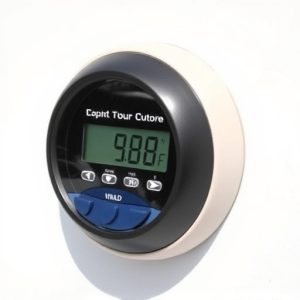Inground Pool Protection: The Role of Swimming Pool Alarms for Home Safety
Swimming pool alarms for inground pools are essential safety devices that detect unauthorized or ac…….
Swimming pool alarms for inground pools are essential safety devices that detect unauthorized or accidental access and trigger an immediate audible alarm to alert homeowners of potential drowning risks. These systems are integral to a comprehensive pool safety strategy and should be integrated with regular maintenance and testing to ensure reliability during emergencies. They operate via motion sensors installed around the pool perimeter, connected to an alarm unit, and can be complemented by home security systems for remote monitoring. It's important for homeowners to understand how these alarms function and recognize them as a supportive measure alongside direct supervision. In addition to being an indispensable safety measure, swimming pool alarms are often a legal requirement in various jurisdictions, highlighting their critical role in pool safety protocols. When selecting an alarm system, consider the specific needs of your household, including the type of alarm that best suits your pool's design and usage patterns, whether it be surface wave or underwater motion detectors. For maximum protection, consider systems with both types of detection features. Always ensure compliance with local regulations and endorsements from safety organizations for optimal effectiveness in safeguarding inground pools. A holistic approach to inground pool safety includes secure gates, barrier fencing, safety covers, first aid and CPR training, family swimming lessons, safety signage, and consistent communication of safety protocols. This comprehensive strategy is vital for creating a safe environment for all swimmers, particularly children who are at higher risk for unsupervised pool access.
When safeguarding your inground pool, swimming pool alarms are indispensable tools for homeowners. These systems not only ensure a secure environment but also act as a vigilant guardian against unauthorized access. In this comprehensive guide, we’ll navigate the essentials of choosing and installing the right inground pool alarm for your family’s safety. From understanding their function to maintaining them effectively, learn how these alarms can be a cornerstone in your overall pool safety strategy.
Understanding Inground Pool Alarms: A Safety Necessity for Homeowners
Swimming pool alarms for inground pools serve as a critical safety measure for homeowners with backyard swimming pools. These systems are designed to detect unauthorized access or accidental falls into the pool, providing an immediate audible alarm to alert the occupants and deter potential tragedies. Understanding the functionality of these alarms is essential for effective pool safety management. Typically, inground pool alarms consist of a motion detector placed around the perimeter of the pool, connected to an alarm unit that sounds upon detection of movement within the pool area when unauthorized. This early warning system can be a lifesaver, especially for households with young children or pets, by providing a timely response mechanism against drowning incidents. It’s also important to note that these alarms are not a substitute for supervision but rather a complementary tool in a layered approach to pool safety. Regular maintenance and testing of the alarm system ensure its reliability and readiness to function in an emergency, making it an indispensable component of inground pool protection.
The Importance of Swimming Pool Alarms: Preventing Unauthorized Access
When it comes to safeguarding an inground pool, one of the most critical components is a reliable swimming pool alarm system. These alarms are designed to detect unauthorized access and immediately notify pool owners or designated caretakers. By setting up perimeter alarms around the pool area, homeowners can be alerted in real-time to any potential dangers, such as children or pets wandering into the pool vicinity without supervision. This proactive measure serves as a vital deterrent against accidental or intentional unauthorized use of the pool, which can prevent tragic incidents of drowning. The sensitivity and specificity of these alarms are crucial; they must be capable of distinguishing between authorized and unauthorized entries to avoid false alarms while ensuring true threats are promptly addressed. Additionally, with advanced technology, swimming pool alarms for inground pools can integrate seamlessly with other home security systems, providing a comprehensive safety solution that enhances the overall security of the property. This integration allows for remote monitoring and notifications, giving peace of mind to pool owners who wish to ensure their pool is protected at all times. The use of swimming pool alarms is not just a responsible choice for families with young children or pets but also a legal requirement in many regions, reflecting the importance of this safety feature.
Types of Inground Pool Alarms: Choosing the Right System for Your Family
When safeguarding your family, especially children and pets, from unauthorized access to an inground pool, selecting the right swimming pool alarm is paramount. Inground pool alarms for homes with young families or pets come in various forms, each tailored to meet specific safety needs. There are two primary types of alarms: surface wave and underwater motion detectors. Surface wave alarms detect disturbances on the water’s surface, triggered by anything moving across it. They are often user-friendly, with audible alerts that can be heard both inside the home and poolside. These alarms are ideal for households with a higher risk of accidental drownings due to their immediate response feature.
On the other hand, underwater motion detectors are designed to monitor the perimeter of the pool, alerting homeowners to any movement in the water. They can be more robust in deterring unauthorized use as they are less susceptible to false alarms from surface disturbances like rain or leaves. When choosing between these two types, consider factors such as your pool’s layout, the level of security required, and the frequency of use by authorized swimmers. Additionally, some systems offer both surface and underwater detection capabilities for a comprehensive safety solution. Regardless of the system you opt for, ensure it complies with local regulations and is approved by reputable safety organizations to guarantee its efficacy in protecting your loved ones.
Installing and Maintaining Your Inground Pool Alarm: A Step-by-Step Guide
When it comes to ensuring the safety of your inground pool, installing a reliable alarm system is paramount. Swimming pool alarms for ingground pools serve as a critical layer of protection against accidental or unauthorized access, particularly for homes with children or pets. The installation process typically involves selecting a location for the alarm sensor near the pool’s entry point, ensuring it has a clear line of sight to the water. Follow the manufacturer’s instructions carefully, which usually include attaching the sensor to a mounting bracket and connecting it to the control unit, often placed inside your home. The control unit is connected to your home’s power supply and can be linked with a second unit for remote monitoring.
Once installed, maintaining your inground pool alarm requires consistent testing and battery replacement as per the manufacturer’s guidelines. Regularly test the alarm by triggering it during non-use times to ensure it responds accurately. Keep an eye on the low battery indicator and replace batteries promptly to avoid a dead alarm in an emergency. Additionally, consider the type of alarm that suits your needs best; some models use motion detectors, while others are wave or tilt sensitive. Regardless of the type, make sure it is free from obstructions and debris that could interfere with its functionality. Proactive maintenance ensures that your inground pool alarm remains a reliable sentinel, providing peace of mind for you and your loved ones.
Best Practices for Pool Safety: Complementing Alarms with Additional Measures
Inground pool safety is paramount, and while automatic swimming pool alarms for inground pools serve as a vital first line of defense in accident prevention, they are most effective when integrated into a comprehensive safety strategy. It’s crucial to complement these alarms with additional measures to ensure the utmost protection for swimmers, especially children who are at higher risk of unsupervised access to the water. A robust safety plan might include securing the pool area with a self-latching, child-resistant gate and installing barrier fencing that meets local ordinances and adheres to industry standards like those set by the American Society for Testing and Materials (ASTM). Furthermore, consistent maintenance of pool barriers and immediate repair or replacement of any compromised components are necessary to maintain their effectiveness. Homeowners should also consider safety covers that can be locked when the pool is not in use, as these provide an additional layer of protection against unauthorized access. Regular inspections of all safety equipment, including alarms, and prompt replacement or upgrades as technology advances will further enhance pool safety.
In addition to physical barriers and alarms, education plays a significant role. All household members, especially those who are responsible for pool supervision, should be trained in first aid and CPR. Swimming lessons for all age groups within the home can empower individuals with the skills needed to handle emergencies. Additionally, clear signage around the pool area that outlines safety rules and protocols can act as a constant reminder of safe swimming practices. Regular communication about pool safety protocols and consistent drills can reinforce these habits, fostering a culture of vigilance and preparedness within the household. By implementing these best practices, homeowners can significantly reduce the risk of accidental drownings and create a safer environment for everyone using the inground pool.


